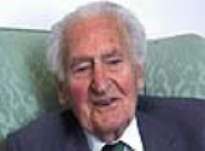Sir Richard Doll - Interview 31

Age at interview: 92
Brief Outline: Sir Richard Doll was one of the doctors who first demonstrated the link between lung cancer and smoking. He was Warden of Green College, Oxford. He was interviewed shortly before his death, in 2005.
Background: Sir Richard Doll was an eminent public health doctor and a pioneer of clinical trials.
More about me...
Sir Richard Doll explains why it can be useful for trials to compare several things at once and why it is important to have enough participants to get a reliable result.
Sir Richard Doll explains why it can be useful for trials to compare several things at once and why it is important to have enough participants to get a reliable result.
SHOW TEXT VERSION
PRINT TRANSCRIPT
Yes. There are two things I’d like to mention.
One was something that, I pressed very hard but I wasn’t the first person to do it. That was that if you’re going to do a clinical trial then it takes a lot of organisation and a certain, lot of working and it takes time. For goodness sake, test two or three things at once. Don’t just one, just test one thing. So we introduced the factorial trial, in which two treatments can be used at once was for, in, in, in four groups of treatment. Both having A, both having B having A and B and having neither so we introduced this trial. This type of trial had been introduced by somebody else, I forget whose name, in the 40s but I got very keen on that and expanded that. And the second thing was, occurred a good deal later, was Peto’s realisation that the great majority of trials that were being carried out were too small to give a clear answer and as a result people were not convinced about the results because one person would carry out the trial of a new drug, get a positive effect and somebody else would do a trial and wouldn’t get a significant effect and they’d say “Oh, there’s a conflict”. Peto said, “Look, the trouble is you’re treating a hundred patients, or a few hundred, even a thousand. You’ve got to treat ten thousand to get a clear answer if you’re going to have moderately small, moderate effects which can be very important for a common disease like myocardial infarction.” And Peto’s insistence that you needed a very large number to get clear answer and his demonstration that you could do this and he, he in the so called ISIS series of controlled trials Oxford, he had 20-30,000 patients in a trial. So I think that was the next most important development and it’s got absolutely clear answers and people’s treat- prescribing habits changed overnight when you got the results of these very large trials.
FOOTNOTE' The number needed for each trial (the ‘sample size’) is proposed by statisticians doing ‘power calculations’. In some cases a small number of participants may be enough, but as Sir Richard explains, if you are looking for fairly small changes in outcome you will need large numbers of participants to pick these up reliably.
Sir Richard Doll was a pioneer of clinical trials in the twentieth century.
Sir Richard Doll, a pioneer of clinical trials, explains an early attempt to run a randomised trial with wounded soldiers during WWII, and the lack of understanding from his superiors.
Sir Richard Doll, a pioneer of clinical trials, explains an early attempt to run a randomised trial with wounded soldiers during WWII, and the lack of understanding from his superiors.
SHOW TEXT VERSION
PRINT TRANSCRIPT
In the first year of the war I tried to do a prophylactic trial of the value of the relatively newly introduced sulphonamides* and the question was, which we didn’t know an answer to at that time' Do you wait until a wound has become infected before you give the treatment, or do you give treatment prophylactically when a person is wounded? And I thought well, in normal civilian life the wounds would be through a car accident or something, but when I went into the army I was a regimental medical officer in 1939 and I thought well now, it would be good to do a trial on wounded soldiers that, and I could, I would not of course I would only treat them very superficially before sending them back to an ambulance or a hospital but I could test whether or not it was good to give sulphonamide prophylactically and I would give half of them sulphonamides and the other half alternately not sulphonamides and then keep a record; and we’d see later which ones, if there was any difference in the infection rate. So [laughs] I went to the senior medical person in our division, what we call the Assistant Director of Medical Services, and asked if I could have a supply, or rather I wrote to him, asked if I could have a supply of sulphonamide for this purpose. Well he sent for me and he said, “What’s this you’re suggesting? If sulphonamides are good and prevent infection then you should give all the soldiers that. If they’re no good then you mustn’t waste his Majesty’s money and it’s ridiculous.” So I said, “Yes sir, well but can you tell me which it is, are they good or not?” He said, “Oh I don’t know, that’s your job.”
* Footnote' Sulphonamides are an anti-bacterial treatment

